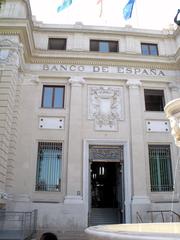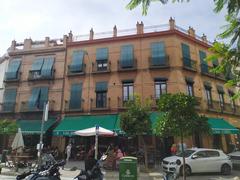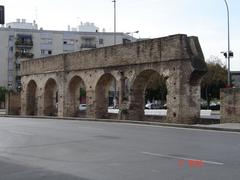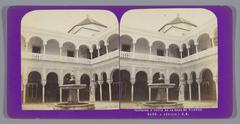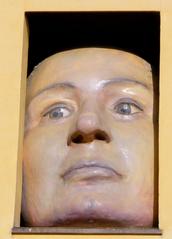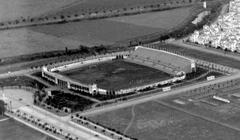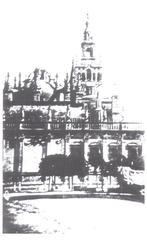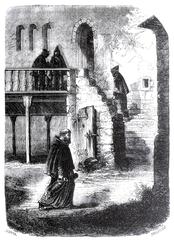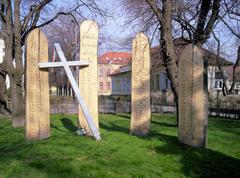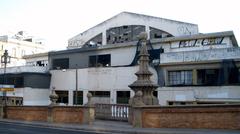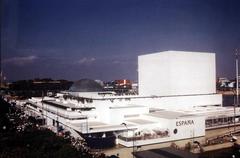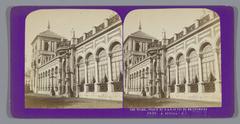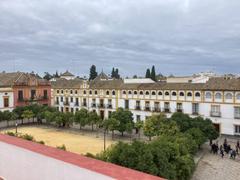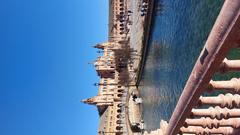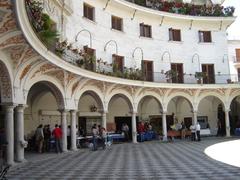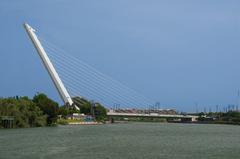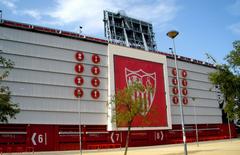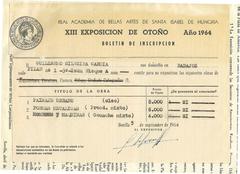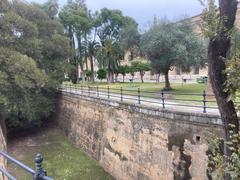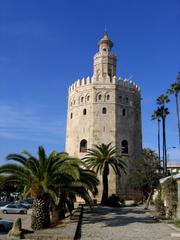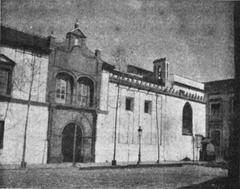
Comprehensive Guide to Visiting Muelle De La Sal, Seville, Spain
Date: 18/08/2024
Introduction
Discover the enchanting Muelle de la Sal, a historical gem nestled along the Guadalquivir River in Seville, Spain. This guide delves into the rich tapestry of Muelle de la Sal’s past, its transformation over the centuries, and its current role as a vibrant cultural landmark. Initially built in the 18th century to facilitate the storage and distribution of salt from Sanlúcar de Barrameda, the wharf has been a cornerstone of Seville’s commercial and cultural life for centuries. As commerce flourished along the Guadalquivir River, Muelle de la Sal emerged as a critical node connecting Seville to other European and American ports, playing a vital role in the city’s economic boom (Union App). Over time, the area has evolved, integrating modern amenities while preserving its historical essence. Today, Muelle de la Sal is not just a relic of the past but a thriving hub for cultural events, festivals, and public gatherings. Whether you are a history enthusiast, a cultural explorer, or simply a traveler looking to soak in the scenic beauty of Seville, Muelle de la Sal offers a unique experience that captures the essence of Andalusian heritage. This comprehensive guide provides essential visitor information, highlights nearby attractions, and offers practical tips to ensure a memorable visit.
Table of Contents
- Introduction
- History of Muelle De La Sal
- Visitor Information
- Special Events and Festivals
- Modern-Day Relevance
- Preservation and Maintenance
- FAQ
- Conclusion
Exploring Muelle de la Sal: History, Visitor Information, and Cultural Significance in Seville
Introduction
Discover the rich history and cultural significance of the Muelle de la Sal, a historical wharf located along the Guadalquivir River in Seville, Spain. This article will guide you through its fascinating past, provide essential visitor information, and highlight its modern-day relevance as a cultural landmark.
History of Muelle De La Sal
Construction and Initial Function
The Muelle de la Sal, constructed in the 18th century, was part of a broader expansion plan for the port of Seville. Initially, it served as a hub for receiving and storing salt from the nearby salt flats of Sanlúcar de Barrameda, a vital commodity for the region’s economy (Union App).
Role in Commerce
As commerce along the Guadalquivir River grew, the Muelle de la Sal became a vital connection point between Seville and other European and American ports. It facilitated the import and export of various goods, significantly contributing to Seville’s economic boom (Union App).
Transformations and Reconstructions
Over the years, the Muelle de la Sal underwent several transformations. In the 19th century, a building was constructed adjacent to the wharf, now repurposed as a cultural center promoting Sevillian culture (Union App).
Connection to the Fishing Industry
Initially intended for distributing salt within Seville, the Muelle de la Sal later supplied fishing boats that docked nearby, highlighting its adaptability (Wikipedia).
Architectural and Cultural Significance
The area around the wharf, including structures by Portilla, White y Cía, adds to its historical charm. These structures are a testament to Seville’s industrial heritage (Wikipedia).
Visitor Information
Visiting Hours and Tickets
The Muelle de la Sal is open to visitors year-round. While there is no entrance fee to explore the wharf itself, nearby cultural centers and events may have specific ticket prices.
Travel Tips and Accessibility
The Muelle de la Sal is easily accessible by foot from central Seville. Public transportation options, including buses and trams, also provide convenient access. The site is wheelchair accessible, ensuring all visitors can enjoy its offerings.
Nearby Attractions
Visitors can explore nearby attractions such as the Torre del Oro, the Paseo de Colón, and the Barranco fish market, making the Muelle de la Sal an ideal starting point for a historical tour of Seville.
Special Events and Festivals
Velá de San Miguel
One notable event is the Velá de San Miguel, an autumn fair dating back to the 13th century. Initially a livestock and agricultural fair, it has evolved into a festive celebration featuring gastronomic stalls, concerts, and various attractions (Visit Sevilla).
Guided Tours and Photographic Spots
Guided tours are available for those interested in a deeper understanding of the site’s history. The wharf’s picturesque setting along the Guadalquivir River also makes it a favored spot for photographers.
Modern-Day Relevance
Today, the Muelle de la Sal is a popular tourist destination offering a blend of history, culture, and scenic beauty. Visitors can enjoy a stroll along the riverbank, dine at nearby restaurants, or participate in various cultural and sporting events held throughout the year (Union App).
Preservation and Maintenance
Efforts to preserve and maintain the Muelle de la Sal are ongoing, ensuring its historical and architectural integrity. These efforts are crucial for maintaining its status as a significant cultural and historical site in Seville (Together to Wherever).
FAQ
What are the visiting hours for Muelle de la Sal?
The Muelle de la Sal is open to visitors year-round, with no specific visiting hours.
Is there an entrance fee?
There is no entrance fee to explore the wharf itself, but nearby cultural centers may have specific ticket prices.
How can I get to Muelle de la Sal?
The site is easily accessible by foot from central Seville, with public transportation options available.
Are there guided tours available?
Yes, guided tours are available for those interested in a deeper understanding of the site’s history.
Conclusion
The Muelle de la Sal is more than just a historical site; it is a living testament to Seville’s rich cultural and economic history. Its evolution from a salt storage facility to a bustling commercial hub and now a cultural landmark underscores its enduring significance. For anyone visiting Seville, the Muelle de la Sal offers a unique glimpse into the city’s past and present, making it a must-visit destination.
Visitor Tips and Recommendations for Muelle De La Sal: Seville’s Riverside Gem
Best Time to Visit
The optimal time to visit Muelle De La Sal is during the spring months of March to May. During this period, Seville is at its most vibrant, with orange trees in full bloom and major celebrations such as Semana Santa (Holy Week) and Feria de Abril taking place. These events add a unique cultural dimension to your visit (rove.me). However, be prepared for crowded hotels and busy streets. If you prefer a quieter experience, consider visiting in the fall (September to October) when the weather is still pleasant, and the city is less crowded.
Getting There
Muelle De La Sal is conveniently located along the Guadalquivir River, making it easily accessible by various modes of transportation. If you are staying in the city center, walking is a great option as it allows you to explore the scenic streets of Seville. Alternatively, you can use public transportation; the nearest metro station is Puerta de Jerez, which is about a 10-minute walk from the site. For those who prefer cycling, Seville is known as the cycling capital of Southern Europe, and there are numerous bike rental services available (rove.me).
Muelle De La Sal Visiting Hours and Tickets
Muelle De La Sal is open to the public 24 hours a day, providing flexibility for visitors to explore at their convenience. There is no admission fee, making it an accessible attraction for everyone. However, if you are interested in guided tours or specific events, it’s best to check the official Seville tourism website for the latest information on ticket prices and availability.
What to Bring
- Comfortable Footwear: The area around Muelle De La Sal is best explored on foot, so comfortable walking shoes are a must.
- Sun Protection: Seville can get quite hot, especially in the summer months. Bring sunscreen, a hat, and sunglasses to protect yourself from the sun.
- Water Bottle: Staying hydrated is crucial, particularly if you plan to walk or cycle around the area.
- Camera: The picturesque views along the Guadalquivir River and the historic architecture make for excellent photo opportunities.
Nearby Attractions
- Torre del Oro: Just a short walk from Muelle De La Sal, this 36-meter high, dodecagonal military tower was built during the Almohad Caliphate to control the river. It now houses a maritime museum and offers stunning views from its rooftop (mexicocassie.com).
- Triana Neighborhood: Known for its long history of glazed tile-making, Triana is a great place to explore local crafts and enjoy some tapas (mexicocassie.com).
- Parque Maria Luisa: A 100-acre park perfect for a leisurely stroll, featuring gardens, patios, and even horse-drawn carriages (mexicocassie.com).
Dining Options
- Tapas Bars: Seville is famous for its tapas, and there are numerous bars around Muelle De La Sal where you can enjoy a variety of small dishes. Popular choices include patatas bravas, jamón ibérico, and gambas al ajillo.
- Riverside Cafés: For a more relaxed dining experience, consider one of the riverside cafés. These spots offer beautiful views of the Guadalquivir River and are perfect for enjoying a leisurely meal or a drink.
- Local Specialties: Don’t miss out on trying local specialties like gazpacho, a refreshing cold soup perfect for hot days, and tinto de verano, a red wine-based cocktail similar to sangria (rove.me).
Activities
- Boat Tours: One of the best ways to experience the Guadalquivir River is by taking a boat tour. These tours offer a unique perspective of Seville’s landmarks and are available throughout the day.
- Cycling and Walking Tours: For those who prefer to stay on land, guided cycling and walking tours are available. These tours often include stops at major attractions and provide insightful commentary on the city’s history and culture (mexicocassie.com).
- Flamenco Shows: Seville is the birthplace of flamenco, and attending a live performance is a must. Many venues offer dinner shows, combining traditional Andalusian cuisine with mesmerizing flamenco dancing (rove.me).
Safety Tips
- Stay Hydrated: The Andalusian sun can be intense, especially in the summer months. Always carry a water bottle and take breaks in the shade.
- Secure Belongings: Like any popular tourist destination, it’s important to be mindful of your belongings. Keep your valuables secure and be aware of your surroundings.
- Follow Local Guidelines: Be sure to follow any local guidelines or restrictions, especially if visiting during a major event or festival. This will ensure a safe and enjoyable experience.
Accessibility
Muelle De La Sal is generally accessible to visitors with mobility issues. The pathways along the river are flat and well-maintained, making it easy for wheelchairs and strollers to navigate. Additionally, many of the nearby attractions, such as Torre del Oro and Parque Maria Luisa, offer accessible facilities.
Local Customs and Etiquette
- Siesta Time: Many shops and businesses close in the afternoon for a siesta, typically between 2 PM and 5 PM. Plan your activities accordingly.
- Dining Hours: Spaniards tend to eat later than in many other countries. Lunch is usually served between 1 PM and 3 PM, while dinner often starts around 9 PM.
- Tipping: Tipping is not mandatory in Spain, but it is appreciated. A small tip of around 5-10% is generally sufficient for good service.
Language
While Spanish is the official language, many people in the tourism industry speak English. However, learning a few basic Spanish phrases can enhance your experience and is always appreciated by locals.
Souvenirs
- Ceramics: Triana is famous for its ceramics, and you can find beautiful handmade tiles and pottery in the local shops.
- Local Foods: Consider bringing home some local delicacies such as olive oil, orange marmalade, or a bottle of sherry.
- Flamenco Accessories: For a unique souvenir, look for flamenco-related items like fans, shawls, or castanets.
Frequently Asked Questions (FAQ)
- What are the visiting hours for Muelle De La Sal? Muelle De La Sal is open to the public 24 hours a day.
- Are there guided tours available at Muelle De La Sal? Yes, guided tours are available. Check the official Seville tourism website for details on schedules and ticket prices.
- Is Muelle De La Sal accessible for people with mobility issues? Yes, the pathways are flat and well-maintained, making it accessible for wheelchairs and strollers.
- What are some good photographic spots at Muelle De La Sal? The views along the Guadalquivir River and the historic architecture offer excellent photo opportunities.
By following these tips and recommendations, you can ensure a memorable and enjoyable visit to Muelle De La Sal and the surrounding areas in Seville. Whether you’re exploring historic landmarks, enjoying local cuisine, or simply taking in the scenic views along the Guadalquivir River, there’s something for everyone to enjoy in this vibrant Andalusian city.
Stay Updated
For more tips and recommendations, download our mobile app Audiala, check out other related posts, or follow us on social media for the latest updates.
Conclusion
Muelle de la Sal stands as a testament to Seville’s rich cultural and economic history, offering visitors a unique blend of past and present. From its origins as a salt storage facility to its transformation into a bustling commercial hub and now a vibrant cultural landmark, the wharf continues to captivate visitors with its historical charm and modern-day relevance. Whether you’re exploring its historical structures, participating in cultural festivals like the Velá de San Miguel, or simply enjoying a leisurely stroll along the Guadalquivir River, Muelle de la Sal provides a multifaceted experience that is both educational and enjoyable. Efforts to preserve and maintain this historical site ensure that its legacy will continue to inspire future generations. For a truly immersive experience, consider joining a guided tour or attending one of the many events held at Muelle de la Sal throughout the year. To stay updated on the latest events and activities, download our mobile app Audiala, check out other related posts, and follow us on social media (Union App, Together to Wherever).
References
- Union App. Muelle de la Sal, Sevilla. Retrieved from Union App
- Wikipedia. Muelle de la Sal. Retrieved from Wikipedia
- Visit Sevilla. Velá de San Miguel: Fair de Autumn Seville. Retrieved from Visit Sevilla
- Diario de Sevilla. Los muelles del rio Guadalquivir: Sal, Delicias y Nueva York. Retrieved from Diario de Sevilla
- Sensational Spain. Seville in Autumn: What to See and Do. Retrieved from Sensational Spain
- La Bienal. Galeria de Imagenes: Muelle de la Sal. Retrieved from La Bienal
- rove.me. Best Time to Visit Seville. Retrieved from rove.me
- mexicocassie.com. 3 Days Seville Itinerary. Retrieved from mexicocassie.com
- Together to Wherever. Seville Itinerary: 3 Days. Retrieved from Together to Wherever





